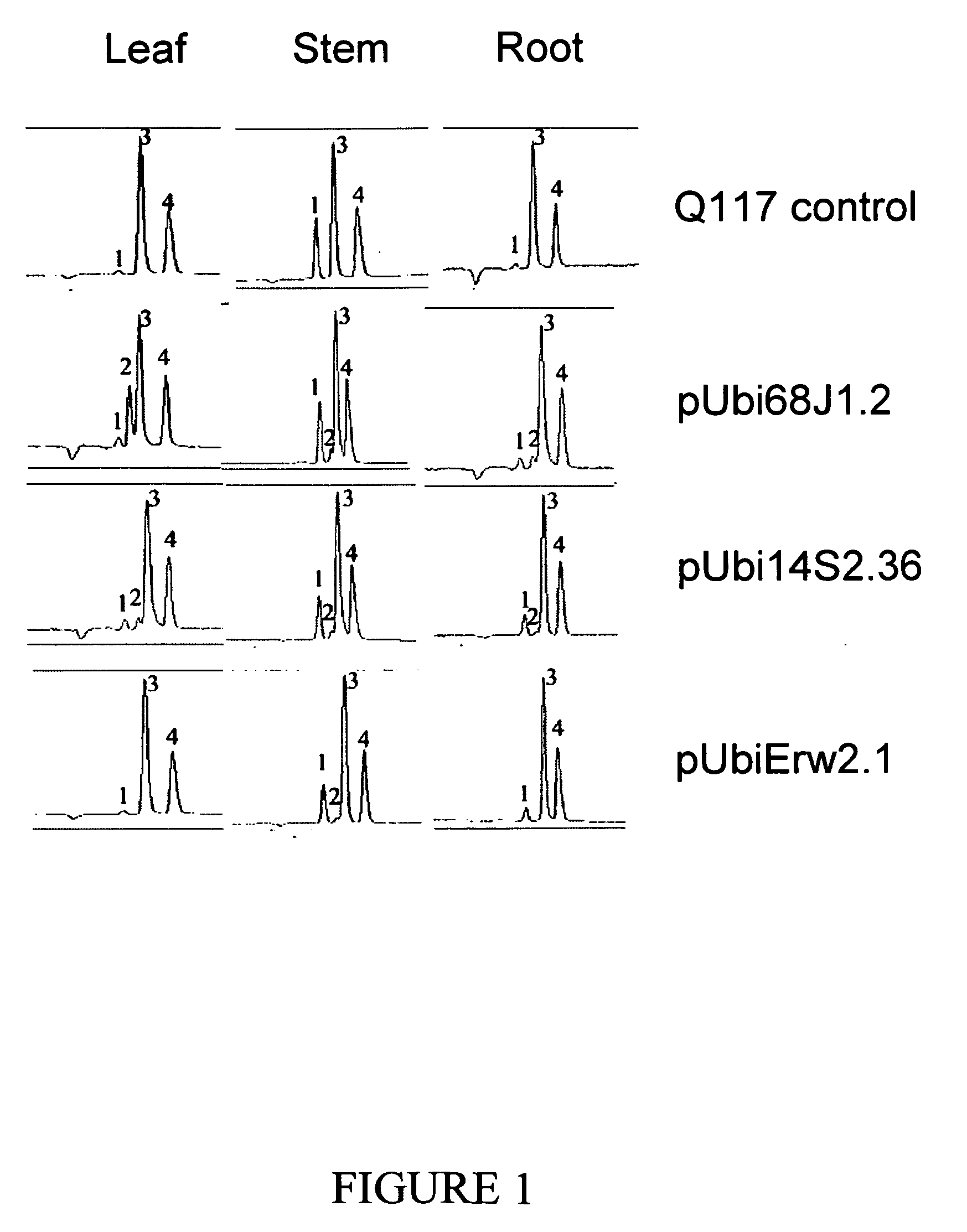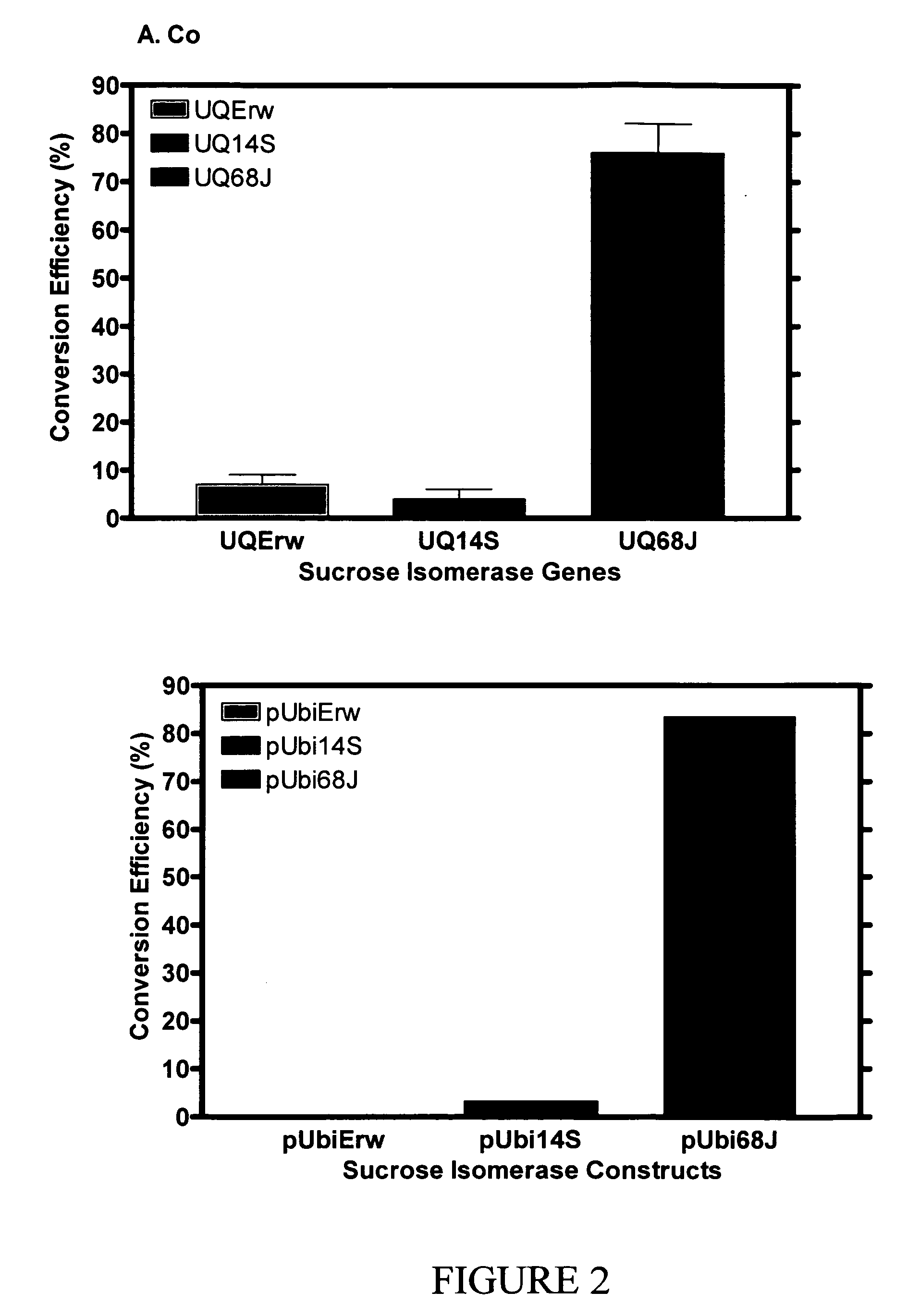Altered metabolism
a technology of metabolic energy and compound, applied in the field of metabolic energy, can solve the problems of severe growth abnormalities, lethal conversion, no useful change in the harvestable yield of sugar, etc., and achieve the effect of increasing the content of an endogenous compound and increasing the total carbohydrate conten
- Summary
- Abstract
- Description
- Claims
- Application Information
AI Technical Summary
Benefits of technology
Problems solved by technology
Method used
Image
Examples
example 1
Expression of Three Sucrose Isomerase Genes in E. Coli
[0185] Sequences of sucrose isomerase genes UQErw (Erwinia rhapontici), UQ14S and UQ68J are described in Birch and Wu (2002). Three pairs of primers were designed for subcloning the three sucrose isomerase (SI) genes into expression vector pET 24b (Novagen). By PCR, non-coding regions and leader sequences were deleted and an artificial start codon was incorporated.
[0186] Each forward primer: 1) includes a start codon, 2) creates a plant-like context for the translation start, 3) incorporates a BamHI restriction site for easily cloning and matching the open reading frame of the gene. Each reverse primer incorporates a KpnI restriction site and includes a stop codon.
[0187] The primer sequences are presented in Table 1 below.
TABLE 1UQErw5′-gga tcc aac aat ggc aac cgt tca gca atcforward:aaa tg-3′[SEQ ID NO:1]UQ14S5′-gga tcc aac aat ggc aac cgt tca caa ggaforward:aag tg-3′[SEQ ID NO:2]UQ68J5′-gga tcc aac aat ggc aac gaa tat aca a...
example 2
Conversion Efficiency from Sucrose into Isomaltulose by Sucrose Isomerases Expressed in E. coli
[0189] Fifteen cultures per SI construct (from Example 1) in BL21 (DE3) were set up in 5 mL LB medium with 50 μg / mL kanamycin. Cells were grown at 37° C. with shaking at 225 rpm. Six to ten cultures per construct, with OD600 1.000±0.005, were selected for further induction. After 0.5 mL was sampled from each culture, IPTG was added to the culture to a final concentration of 1.0 mM. Incubation of the cultures was continued for another 3 hours. The induced cultures only with OD600 1.750±0.005 were further selected for quantification of conversion efficiency from sucrose into isomaltulose, allowing analysis of three replicate cultures per construct.
[0190] A 1.0 mL aliquot of each culture was centrifuged, then the pellet was resuspended in 0.4 mL of 50% sucrose solution buffered with 35.8 mM Na citrate and 128.4 mM Na phosphate (pH 6.0). The suspension was incubated at 370° C. for 48 hours w...
example 3
Construct DNA for Expression of the Cytosol-Targeted SI Genes, Driven by Promoter Ubi (pU3ZErw, pU3Z14S or pU3Z68J)
[0191] The Ubi promoter from the maize ubi-1 gene (Christensen and Quail, 1996, Transgen. Res. 5, 213-218) was employed. For cytoplasmic gene expression in sugarcane cells, the inserts of different SI genes from the pET 24b vectors (Example 1) were further cloned between the Ubi promoter and the Agrobacterium nos polyadenylation region (Bevan et al., 1983, Nature 304, 184-187) in plasmid vector pU3Z, to construct pU3ZErw, pU3Z14S or pU3Z68J plasmids.
PUM
| Property | Measurement | Unit |
|---|---|---|
| temperature | aaaaa | aaaaa |
| Tm | aaaaa | aaaaa |
| pH | aaaaa | aaaaa |
Abstract
Description
Claims
Application Information
 Login to View More
Login to View More - R&D
- Intellectual Property
- Life Sciences
- Materials
- Tech Scout
- Unparalleled Data Quality
- Higher Quality Content
- 60% Fewer Hallucinations
Browse by: Latest US Patents, China's latest patents, Technical Efficacy Thesaurus, Application Domain, Technology Topic, Popular Technical Reports.
© 2025 PatSnap. All rights reserved.Legal|Privacy policy|Modern Slavery Act Transparency Statement|Sitemap|About US| Contact US: help@patsnap.com



